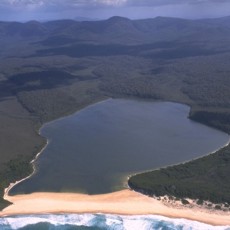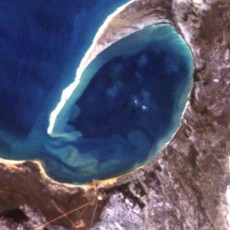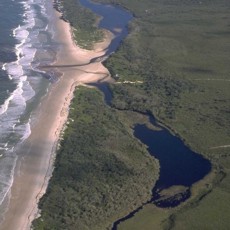Also known as: ICOLL’s, closed or blind estuary, interbarrier estuary, dune-swale creek.
Conceptual model diagrams of coastal lagoons and strandplain-associated creeks

Sedimentary Environments (Habitats)
Hydrology
Sediment Transport
Nitrogen Dynamics
Key features of coastal lagoons and strandplain-associated creeks
- Habitats supported are limited by chemical conditions induced by poor exchange with the marine environment, and highly variable salinity.
- Intermittent entrance isolates the coastal waterway from the ocean for long periods.
- River flow is intermittent to non-existent. Flooding is therefore uncommon, however can cause large impacts such as entrance breaching and scouring of the central basin.
- Turbidity is naturally low, however shallow basins are susceptible to wind-wave resuspension, particularly if seagrasses are not present.
- Central basin (where present) is an efficient ‘trap’ for terrigenous sediment and pollutants.
- Long residence time encourages trapping and processing (e.g. denitrification) of terrigenous nutrient loads, however the system may be susceptible to overloading due to small size.
- Evolution, in terms of infilling, is very slow due to the lack of significant sediment input.
Geomorphology
Coastal lagoons and strandplain-associated coastal creeks are small, shallow basins that have very low (or negligible) freshwater input (see Examples below). In Australia, they are most abundant on the south-east coast, south-west coast, and in the Gulf of Carpentaria. The catchment for these systems is limited to the immediate hinterland. Due to the lack of significant freshwater input (and associated terrigenous sediment) and strong tidal currents, the entrances to these coastal waterways are often intermittently or permanently closed, resulting in isolation from marine influence for long periods (Ranasinghe et al., 1999). The geomorphology of coastal lagoons is similar to wave-dominated estuaries, however they lack a distinct fluvial bay-head delta (Roy et al., 2001). strandplain-associated coastal creeks are narrow, generally shallow water bodies that occur on wave-dominated coasts (Otvos, 2000). They are generally oriented parallel to the coast, and develop on prograding coastal sequences formed from beach ridges, dunes, and barriers. Coastal lagoons, and other small waterways associated with wave-dominated coastlines, tend to experience very low wave and tide energy within, as tidal waters are often unable to penetrate the closed (or very narrow and intermittent) entrances (Harris et al., In Press). Additionally, low or non-existent river flow is conducive to very low energy conditions, except during extreme flood conditions. The most significant physical energy source in many systems is internally generated wind-induced waves, however these usually remain quite small due to the limited size of the waterway (Morrisey, 1995).



Figure 1. Examples of coastal lagoons: Nadgee Lake (NSW), Little Lagoon (NT), and a strandplain-associated coastal creek: Jerusalem Creek (NSW). Oblique photos courtesy of the NSW Department of Land and Water Conservation.
Evolution
Coastal lagoons and strandplain-associated creeks evolve on wave-dominated coastlines by the partial or total closure of small coastal embayments, by a sub-aerial sand barrier, or by the flooding of beach ridges (Harris et al., In Press). Coastal lagoons represent an end member of the spectrum of wave-dominated coastal waterways where fluvial input is negligible, and experience the same or similar evolutionary trends as wave-dominated estuaries except for the lack of significant infilling by terrigenous material (Boyd et al., 1992). Infilling is slow, and is dominated by marine-derived sediment when the entrance is open (Boyd et al., 1992).
Habitats and ecology
Despite intermittently experiencing significant variations in salinity, coastal lagoons and strandplain-associated coastal creeks are usually colonised by estuarine invertebrates and other ‘euryhaline’ aquatic organisms that can tolerate a wide range of salinity conditions (Rainer et al., 1981b). There is usually a high mortality of marine species during periods of closure that provides an opportunity for recruitment and development of estuarine and/or low salinity species. Even very small (<100 m2) coastal lagoons and strandplain-associated coastal creeks are important habitats for a diverse assemblage of juvenile (and small-sized) fishes, some of which are economically important (Griffiths, 2001, Hannan et al., 1998, Norris et al., 1993, Pollard, 1994). The duration of water exchange between the ocean and the coastal lagoon is probably the most important factor influencing the recruitment of marine organisms (Potter et al., 1994). Many coastal lagoons and strandplain-associated coastal creeks support macroalgae, limited seagrass beds, saltmarshes, and floodplain species. Mangroves typically do not occur, due to the lack of connection with the open ocean (Roy et al., 2001).


